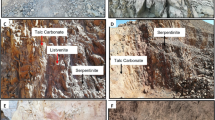Abstract
The Freda-Rebecca Mine is currently the largest gold producer in Zimbabwe. The ore deposit is hosted by two main shear systems crosscutting the Rebecca diorite and Bindura granodiorite (2.65 Ga) as well as Shamvaian metasediments, which are affected by contact metamorphism. Following the intrusion of the Bindura granodiorite, intensive hydrothermal alteration developed preferentially in the dioritic part of the igneous complex (Rebecca diorite). The hydrothermal alteration started with an extensive K-dominated hydrothermal metasomatism in the whole Rebecca diorite. It was followed by less penetrative hydrothermal alteration developed preferentially near shear zones and veinlets. Hydrothermal metasomatism caused microcline and biotite formation, prevailing in the Rebecca diorite. Two main stages of post-metasomatic hydrothermal alteration and mineralization were distinguished, based on spatial relationships between different minerals and some geochemical aspects. In the first stage, an actinolite-tourmaline-arsenopyrite mineralization formed, which is characterized by Ni-Co arsenopyrite associated with actinolite, tourmaline and quartz. The second, lower temperature stage gave a polyphase gold-rich mineralization that developed in four phases which are distinguished by different parageneses including:
Phase 1. Actinolite, chlorite, clinozoisite/epidote, quartz, calcite, arsenopyrite, pyrite, pyrrhotite, chalcopyrite.
Phase 2. Chlorite, epidote, calcite, gold, native Bi, Bi-Pb sulfides, galena, chalcopyrite, fahlore, pyrite, Fe-gersdorffite.
Phase 3. Epidote, calcite, (Ni, Co, Fe) As S phases, Co-Fe-gersdorffite.
Phase 4. Chlorite, calcite, quartz.
The gold mineralization is exclusively associated with phase 2 and developed in three sulfide parageneses:
– Gold + Bi-Pb sulfides + bismuth + chalcopyrite + galena, associated with chlorite (Au 1).
– Gold + galena + pyrite, associated with calcite and chlorite (Au 2).
– Gold + pyrite + Fe-gersdorffite, associated with epidote, chlorite and calcite (Au 3).
The hydrothermal alteration and mineralization formed after the consolidation of the Rebecca diorite and Bindura granodiorite, most probably in the postmagmatic cooling stage. The mineralization was emplaced either synchronously or subsequently to the shear zones which crosscut the consolidated pluton. Not all shear zones are mineralized and different shear zones show different amounts of mineralization and hydrothermal alteration. Thus, it is suggested that during the cooling stage of the pluton and subsequent to the formation of the K-metasomatic zone (microcline + biotite), hydrothermal fluids preferentially followed just forming or pre-existing shear zones. It cannot be excluded that this process developed in a plutonic porphyry copper-like environment, in which the classically hydrothermal zonation did not form due to synchronous tectonic disturbance, which preferentially drives the hydrothermal flow along shear zones. Mineral parageneses and data from chlorite geothermometry indicate that the different stages and phases of hydrothermal alteration reflect cooling stages of the hydrothermal system, from >300 °C in the first stage to about 150 °C in the last phases.
Similar content being viewed by others
Author information
Authors and Affiliations
Additional information
Received: 4 January 1999 / Accepted: 13 August 1999
Rights and permissions
About this article
Cite this article
Klemm, D., Kräutner, H. Hydrothermal alteration and associated mineralization in the Freda-Rebecca gold deposit – Bindura District, Zimbabwe. Mineral. Deposita 35, 90–108 (2000). https://doi.org/10.1007/s001260050009
Issue Date:
DOI: https://doi.org/10.1007/s001260050009




